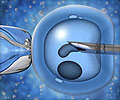As of now environmentalists blame pollution and psychiatrists people's stressful lifestyles for fertility problems in about 10 per cent of all couples hoping for a baby. However researchers at the Tel Aviv University have a different explanation.
Dr. Oren Hasson, an evolutionary biologist in the university's Department of Zoology, says that the reproductive organs of men and women are currently involved in an evolutionary arms race, and the fight is yet not over."The rate of human infertility is higher than we should expect it to be. By now, evolution should have improved our reproductive success rate. Something else is going on," says Dr. Hasson.
The researchers combined empirical evidence with a mathematical model, and came to the conclusion that the bodies of men and women have become reproductive antagonists, not reproductive partners.
Writing in the journal Biological Reviews, Dr. Hasson points out that, over thousands of years of evolution, women's bodies have forced sperm to become more competitive, rewarding the "super-sperm" - the strongest, fastest swimmers - with penetration of the egg.
The researcher further states that men, in response, are over-producing these aggressive sperm, producing many dozens of millions of them to increase their chances for successful fertilization.
However, according to Dr. Hasson, these evolutionary strategies demonstrate the Law of Unintended Consequences as well.
Advertisement
Dr. Hasson says that the unintended consequences have much to do with timing.
Advertisement
This blockade is necessary because a second penetrating sperm would kill the egg, adds the researcher.
However, says Dr. Hasson, in just the few minutes it takes for the blockade to complete, today's over-competitive sperm may be penetrating, terminating the fertilization just after it's begun.
Women's bodies, too, have been developing defences to this condition, known as "polyspermy".
"To avoid the fatal consequences of polyspermy, female reproductive tracts have evolved to become formidable barriers to sperm. They eject, dilute, divert and kill spermatozoa so that only about a single spermatozoon gets into the vicinity of a viable egg at the right time," says Dr. Hasson.
The researcher notes that any small improvement in male sperm efficiency is matched by a response in the female reproductive system.
"This fuels the 'arms race' between the sexes and leads to the evolutionary cycle going on right now in the entire animal world," the researcher says.
According to Dr. Hasson, sperm have also become more sensitive to environmental stressors like anxious lifestyles or polluted environments.
"Armed only with short-sighted natural selection, nature could not have foreseen those stressors. This is the pattern of any arms race. A greater investment in weapons and defences entails greater risks and a more fragile equilibrium," Dr. Hasson argues.
He says that infertile marriages can be stressful, but unlike birds, humans have the capacity for rational thinking.
He advises infertile couples to openly communicate about all their options, and seek counselling if necessary.
Source-ANI
RAS














